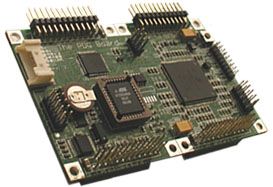


 | |

|
Loading
|

| |
|
|
Mosaic embedded designs » Embedded controllers » Single board computers » Tiny HCS12 instrument controller PDQ Board™ - Your Low cost solution to instrument control
A Small and Mighty HCS12 Embedded Development BoardThe PDQ Board is an OEM HCS12 single board computer that dramatically cuts the cost of data acquisition and control. This embedded development board packs 1 megabyte of memory, communications, dozens of analog and digital I/O lines, and dual expansion I/O buses onto a compact low-cost board. This fast low power microcontroller measuring just 2.5" x 4" is an elegant alternative to pc104 and is ideal for instrumentation, industrial control, automation, and data acquisition. The PDQ Board hosts a fast Freescale MC9S12A512 microprocessor (similar to the MC9S12DP512 and also known as HCS12 or 9S12). This 16 bit microcontroller sports a 16-bit data bus and uses a phase locked loop (PLL) to synthesize a 40MHz internal clock and 20MHz bus clock, resulting in execution speeds 8 times faster than the 8-bit 68HC11 processor. The processor's native address space is only 64K, so a paging architecture is used to expand the addressable memory to 1 MByte. The address space is populated by 512K internal Flash, 14K internal RAM, 1K processor registers, 1K internal EEPROM (384B usable by application), plus 496K of fast off-chip RAM. The off-chip RAM comprises 16K of "common" unpaged RAM that is available for data storage regardless of the page, and 480 Kbytes of paged RAM. The paged RAM is "shadowed" by external Flash that acts like an onboard disk drive, restoring your program code from Flash memory each time the board is powered up. This flexible memory architecture allows for both RAM- and Flash-intensive applications, and makes program development a snap. HCS12/9S12 Hardware and Software InterfacingHardware and software interfacing is done for you, so you can speed your microcontroller project to market. All of the HCS12/9S12 hardware resources are fully supported with precoded software drivers, easily accessed by a high level GNU C compiler and full featured integrated development environment (IDE). Lots of I/OThe PDQ Board packs dozens of analog and digital I/O lines plus versatile serial communications links onto a compact board. It delivers 8 digital I/O lines with counter/timer capabilities, 8 pulse-width modulated (PWM) digital output signals, and 8 general purpose digital I/O lines. Additional I/O includes sixteen analog inputs with 10-bit resolution, dual RS232/485 ports with speeds to 256 KBaud, and synchronous SPI and IIC serial interfaces. Any of the digital I/O ports can be configured for general purpose I/O, and the analog input lines can be configured as digital inputs. A battery-backed real-time clock reports the time and date. Programmable in C or ForthThe PDQ Board is easily programmable in C, Forth or Assembly using any PC. Built-in programming tools include a multitasking executive and comprehensive device-driver libraries. All functions can be called interactively from the terminal to speed the debugging process. In addition, the processor implements a "Background Debug Mode" (BDM) in hardware that facilitates real-time debugging. An available attachment to your desktop PC connects to the BDM port on the board, enabling you to set breakpoints, single step, and trace to diagnose your program at runtime. Turn your instrument into an embedded web serverUse Mosaic's EtherSmart Wildcard, a 2x2.5" modular board to web-enable your PDQ Board. The Ethersmart Wildcard enables communications between your instrument and other computers or peripherals via a Local Area Network (LAN) using the standard packet-based Ethernet signaling protocol. Simply plug a standard Ethernet cable into the RJ-45 jack on the Wildcard, and your instrument can communicate with other computers on a Local Area Network (LAN). Want to go wireless? Use the WiFi Wildcard which implements a wireless interface via a Wireless Local Area Network (WLAN) using the standard 802.11b/g packet-based protocol. Your application program can send emails to alert other computers on the network when significant events occur. You can even "browse into" your instrument using a browser running on an online PC to monitor the status of your instrument. Mix and match stackable I/O expansion modulesConvenient connectors allow for simple mechanical integration. The PDQ Board can directly host up to 8 I/O expansion modules called Wildcards™ that you can mix and match depending on your application. The easy to use Wildcards stack onto the dual 24 pin Wildcard connectors on the PDQ Board. A Docking Panel module includes an efficient switching power regulator, dual DB-9 serial connectors, optional DB25 connectors, a power jack, an on/off switch, and an optional cover plate to simplify enclosure mounting. Wildcards implement a wide variety of user interface, communications, data acquisition and control capabilities. Available Wildcards include Ethernet, WiFi, GPS, Keypad/Display module, octal 12-bit D/A and 16-bit A/D converters, a 24-bit resolution analog data acquisition subsystem, Compact Flash card mass memory interface, fast buffered RS232/485 dual UART, high voltage/high current isolated I/O, and AC or DC solid state relays. You can select the Wildcards that meet your needs to configure a cost-effective customized controller for your application. Use OEM HCS12 boards for fast time to marketFor a quick and easy start, to rapidly prototype using the PDQ Board, order a PDQ Board Starter Kit Block Diagram
Specifications
Home | Site Map | Products | Documentation | Resources | Order | About Us HCS12 Boards | OEM Custom HCS12 Single Board Computers / SBC | HCS12 Embedded Development Boards | HCS12/9S12 Hardware and Software Interfacing | |||||||||||||||||